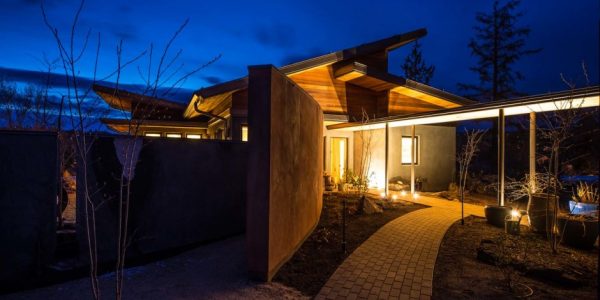‘Desert Rain’ Achieves Living Building Challenge Certification

We are very proud to share that Bend is now home to the United State’s first ever Living Building Challenge (LBC) residence! This is a tremendous accomplishment, and we’re excited to have this shining example of green building right here in our own community.
 The home, called ‘Desert Rain’, is owned by locals Tom Elliott and Barbara Scott. Elliott and Scott, alongside Lead Designer Al Tozer Jr., began their home-building process with the admirable goal to design a LEED-certified home using the latest green technology. However, early in their journey, they were inspired to step it up a notch and design the house to match the LBC – which hadn’t before been accomplished in our country for a single-family home. (In fact, only a handful of buildings across the world have earned the LBC, and most of them are office buildings or educational institutions.)
The home, called ‘Desert Rain’, is owned by locals Tom Elliott and Barbara Scott. Elliott and Scott, alongside Lead Designer Al Tozer Jr., began their home-building process with the admirable goal to design a LEED-certified home using the latest green technology. However, early in their journey, they were inspired to step it up a notch and design the house to match the LBC – which hadn’t before been accomplished in our country for a single-family home. (In fact, only a handful of buildings across the world have earned the LBC, and most of them are office buildings or educational institutions.)
The LBC offers the world’s most rigorous proven performance standard for buildings. The end result creates spaces similar to a flower – giving more back to the environment and community than it takes. Going along with this metaphor, LBC categorizes its strict criteria under seven “Petals”: Site, Water, Energy, Health, Materials, Equity and Beauty.
On paper, Desert Rain is a residential compound featuring a main house, two detached apartments and three garages. The house goes far beyond all baseline efficiency standards and features many unique aspects, including vacuum toilets; reclaimed lumber from the two original homes on the site, as well as a potato barn near Prineville; recycled glass formed into bathroom tile; and triple-pane windows. Among its impressive list of stats, the house boasts:
100% net-zero energy
A 14.95-kilowatt solar-electric system generates electricity for the home’s appliances and lighting — and powers two electric vehicles. Solar-thermal heating systems heat the floors and domestic water.
100% self-contained rainwater collection and 100% processing of wastewater
The property captures and processes rain and snow melt on-site for drinking and other household needs. There is a 35,000-gallon cistern to store rainwater tucked under the two-car garage. Both graywater and blackwater are treated and returned back to the site.
Carbon neutral and red list approved
Toxic chemicals were screened from all building materials and all wood was reclaimed or Forest Stewardship Council certified.
To go from “extreme dream” to where they are now has taken quite some time, and has required a lot of patience during several hurdles and challenges. After more than six years, the couple finally moved in in 2015. Once living in the home, they then had to prove performance for one year. The couple completed the final audit in mid-December (after submitting 3,400 supporting documents) and just received final, full certification.
“I think Desert Rain has settled nicely into the Bend landscape,” said Elliott. “Mostly, we are happy to have met the Living Building Challenge. We learned a lot from the process and are glad to be living in our home.”
 This project models a new level of energy efficiency and sustainability that Elliott and Scott hope will serve as a learning tool for others, in a design that is warm and welcoming for all. Open, artfully aesthetic, and practical in how the spaces are used, the Desert Rain home intimately engages with its environment and calls all that enter to be mindful of how they engage, as well.
This project models a new level of energy efficiency and sustainability that Elliott and Scott hope will serve as a learning tool for others, in a design that is warm and welcoming for all. Open, artfully aesthetic, and practical in how the spaces are used, the Desert Rain home intimately engages with its environment and calls all that enter to be mindful of how they engage, as well.
Congratulations, Desert Rain Team! Thanks to your hard work and dedication, Bend is now home to one of the greenest buildings in the world.